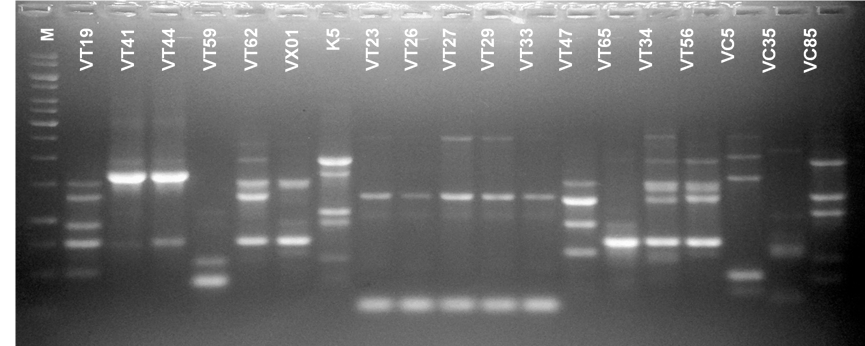


Indian Journal of Science and Technology
Year: 2020, Volume: 13, Issue: 13, Pages: 1412-1422
Original Article
Hoang Tan Quang1, Tran Thuy Lan1, Truong Thi Hong Hai1, Pham Thi Hai Yen2, Tran Quang Khanh Van2, Ho Thi Tung2, Mac Nhu Binh2, Nguyen Khoa Huy Son2, Nguyen Quang Linh3, Nguyen Duy Quynh Tram2*
1Institute of Biotechnology, Hue University, Hue, 530000, Vietnam
2University of Agriculture and Forestry, Hue University, Hue, 530000, Vietnam
3Hue University, Hue, 530000, Vietnam
*Corresponding author
Nguyen Duy Quynh Tram
University of Agriculture and Forestry, Hue University, Hue, 530000, Vietnam
Email: [email protected]
Received Date:16 April 2020, Accepted Date:23 April 2020, Published Date:23 May 2020
Objective: This study was done to report the results of genetic diversity and toxic genes analysis of Vibrio pathogen isolated from white leg shrimp and marine fishes cultured in Thua Thien Hue province, Vietnam. Methods/statistical analysis: Pathogen Vibrio spp. were isolated from shrimps and fishes, and were identified by 16S rRNA sequencing. The presence of toxin genes in Vibrio spp. strains were determined through the presence of genes encoding toxic proteins (pirAvp, pir-Bvp, tlh, tdh and trh) based on specific primers for these genes. Genetic diversity of Vibrio strains was analysed by RAPD technique. Findings: A total of 120 Vibrio colonies from shrimps (with Acute Hepatopancreatic Necrosis Disease) and fishes (with hemorrhagic disease) cultured in Tam Giang lagoon in Thua Thien Hue, Vietnam were isolated. Of which, 14/54 strains from shrimps had pirAvp and pirBvp genes and 18/66 strains from fishes had tlh gene, and none of Vibrio strains had tdh and trh genes. Randomly amplified polymorphic DNA (RAPD) analysis of 36 Vibrio samples showed the 148 polymorphic DNA fragments from ten random primers. The genetic diversity is high within studied species. In there, V. parahaemolyticus has the highest diversity level (h=0.1645 and I=0.2695) while V. shilonii is lowest (h=0.0136) and I=0.0207). The degree of genetic differentiation among species is also high (Gst=0.4827). Genetic identity between V. parahaemolyticus and V. vulnificus (0.9545) is highest while between V. shilonii and V. harveyi (0.7416) is lowest. The dendrogram also showed that V. parahaemolyticus is closely related to V. vulnificus whereas V. shilonii and V. harveyi have large distance. Application/improvements: This study is aimed to provide scientific data as the basis for the study and production of rapid diagnostic kits in the future.
Keywords: AHPND; Genetic diversity; RAPD; toxic genes; Vibrio; Vietnam
Copyright: © 2020 Quang, Lan, Hai, Yen, Van, Tung, Binh, Son, Linh, Tram. This is an open-access article distributed under the terms of the Creative Commons Attribution License, which permits unrestricted use, distribution, and reproduction in any medium, provided the original author and source are credited.
Published By Indian Society for Education and Environment (iSee)
Subscribe now for latest articles and news.